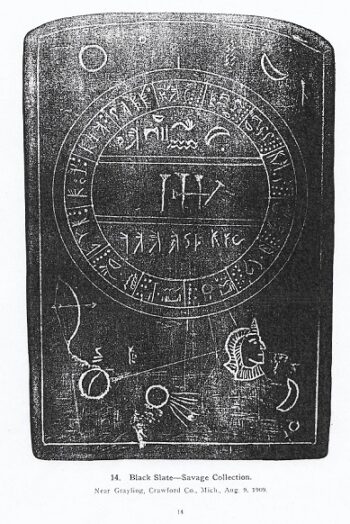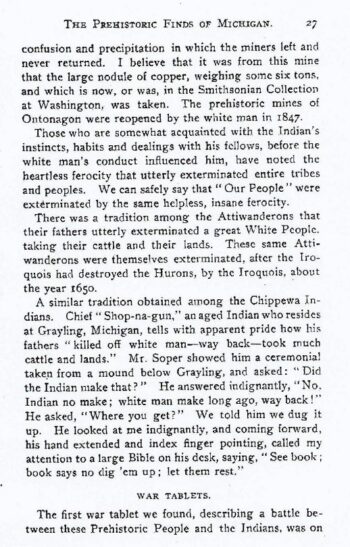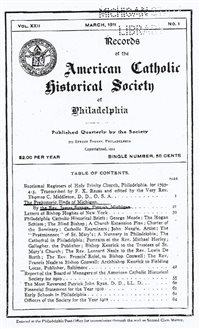NORTHERN MICHIGAN – Many folks believe that until Chris Columbus found the American Continent, no European had set foot on the “new land.”
Chris claimed the discovery on behalf of Queen Isabella of Spain. The only problem was that vast amounts of evidence, pottery shards, tablets, worked copper pieces and so on, suggest that the continent was previously visited by Vikings, Celts, Phoenicians and Hebrews. This evidence has been typically found in the form of carved tablets and other artifacts buried in mounds. Such mounds have been found throughout eastern United States as far away as Iowa, Wisconsin and Maine.
Michigan joined the list of mound states in 1891in the little town of Wyman near Edmore in Montcalm County. J. O. Scotford, a local farmer, was digging some post holes for a new fence when he unearthed some ancient pottery. Further digging in nearby mounds revealed a buried clay tablet with an inscription in an unknown language. Word spread around town and it wasn’t long before an army of folks from the surrounding area started digging into anything that even resembled a mound. A variety of relics were unearthed, pottery shards, more clay tablets, caskets and other items which were engraved with hieroglyphics and unreadable text that seemed to relate to Biblical subject matter.
Experts were called in and when they met with no success in interpreting the tablets, they proceeded to label them all as fake. Many local folks believed the professors were wrong in identifying the artifacts as fake, including the Editor of the “Edmore Journal” who ridiculed the professors saying they were embarrassed because they could not translate the texts.

Discovery of new mounds continued until around 1915 when the digging frenzy cooled down. A former Newaygo newspaper editor, Daniel Soper, emerged as one of the authorities on the artifacts. He discovered so many items that they eventually became known as “Soper Frauds”. The mounds and their artifacts had gained the attention of religious fundamentalists like Rev. Rudolph Etzenhouser of the Jesus Christ of the Latter-Day Saints and a Detroit Catholic Priest, Rev James Savage. For the most part the interest in the mounds and the artifacts had waned with only an occasional re-discovery. Most of the relics have been stored away in musty museum basements.
In 1909 two men from Texas came to Grayling seeking the location of the “Sylvan Club” noted in a book written by Rev. James Savage for the American Catholic Historical Society titled “Prehistoric Finds in Michigan.”
The two men, George Lang and Wesley Carter met Arthur J. Wakeley who took the men directly to the site of some mounds located near the AuSable River. According to Bishop Savage’s book, several tablets and other artifacts were removed from the mounds. In addition to being able to lead the men to the mound site, Mr. Wakeley was also able to discuss Savage’s work, having known the man personally and helped with the excavation some seventy years earlier. After investigating the existing mounds and deciding that all the relics had been recovered previously, Lang and Carter planned to return later and search for other, unexcavated mounds they were certain must be in the area.
Both men belonged to a religious group called the “Holy Ground Mission” who believe they have been called by God to “Accomplish the restitution of all things before Christ can return”.

Mr. Wakeley told of being at the Savage cabin where recovered relics were spread out in the front porch. He said most folks in the area believed the relics were part of an elaborate hoax having been buried long ago for folks to “find.” Both Lang and Carter believe they may have been placed there by visiting Europeans who lived and traded in North America as much as 3,000 years ago.
Probably the most telling synopsis of the mounds found in Crawford County may be found in the American Catholic Historical Society issue of March 1911. Starting on page 21 of that publication is an article by the Rev. James Savage of Detroit, Michigan titled “The Historic Finds of Michigan”. Rev. Savage’s accounting of the various Michigan mounds and their contents includes evidence going back to the early copper mines dug by the Native Americans for both tools and trade.
One of the significant facts emphasized by Savage’s findings supported the reports of inter-tribal savagery. They thought nothing of totally exterminating opposing tribes when conflicts arose. It is logical to suppose that this same aggressiveness was applied to any “white man” who may have tried to settle where they were not wanted.
“There was a tradition among the Attiwanderons that their fathers utterly exterminated a great White People taking their cattle and their lands – A similar tradition existed among the Chippewa Indians. Chief Shop-na-gun, an aged Indian who resides in Grayling, Michigan, tells with apparent pride how his father’s “killed off white men – way back – took much cattle and lands”, (page 27, March 1911 issue).
Rev. Savage goes on to describe more than 500 mounds that he and his associates opened in the counties they had researched. He specifically refers to the mounds found near the Sylvan Club totaling 11 sites on the Clubs two, 40-acre plots. Copper tools, clay pipes, stone tools, wooden caskets and sandstone medals were uncovered. Rev. Savage expressed great belief that they were on just the edge of a major site of ancient “mound builder” activity in Crawford County.
According to the reports, many of the tablets and artifacts recovered from the Crawford County mounds are housed in the collection at Central Michigan University where they were taken by the professors that originally labeled them as fakes. Were they really fakes or are these relics really evidence of visitation and settlement by white men as much as 3,000 years ago? Will there be a revitalized interest in seeking additional mounds? Will old artifacts be re-evaluated with modern technology? Only time will tell.
The Crawford County Historical Society and Museum has extensive information on Michigan Mounds including a copy of the original Rev. Savage manuscript as published in the American Catholic Historical Society quarterly report. These documents, as well as much more information about Crawford County’s history, is available at the Museum located in the old Grayling Railway Depot. During the “off season”, access to the collection is by appointment made through one of the Directors.


